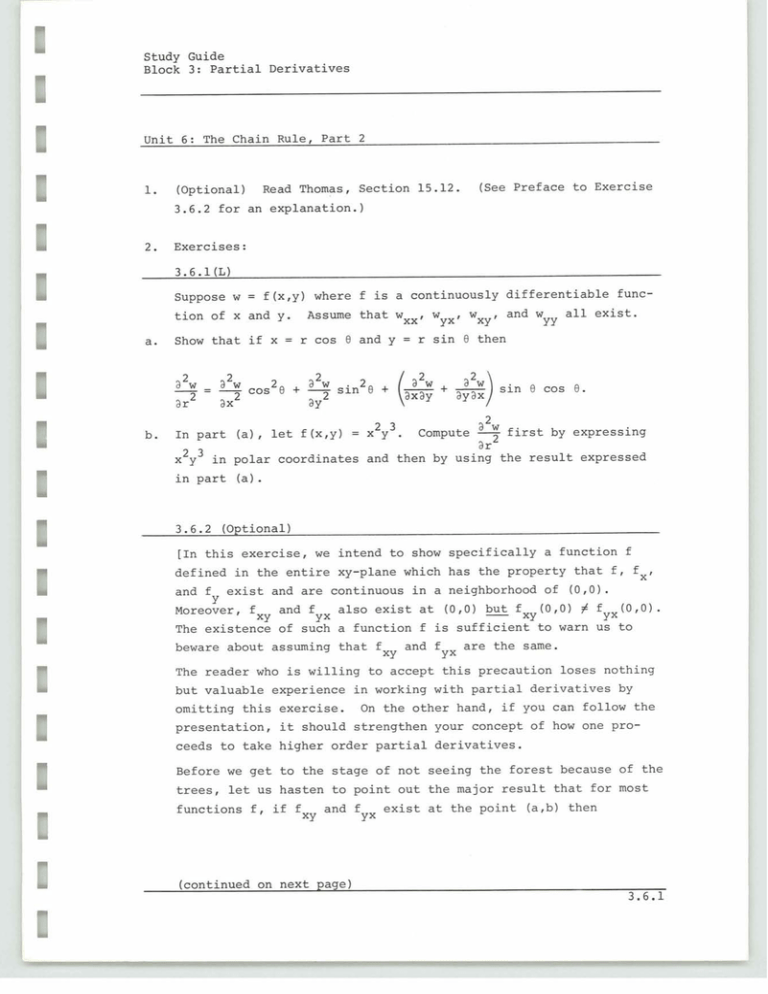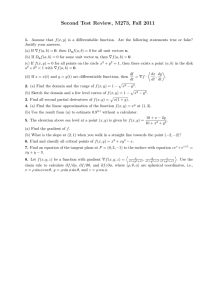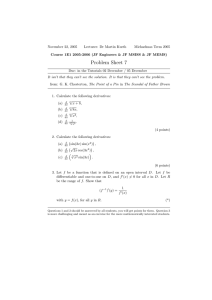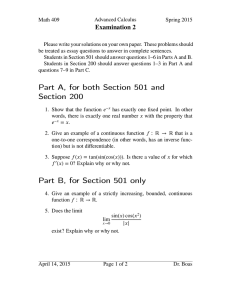Document 13650779
advertisement

Study Guide Block 3: Partial Derivatives Unit 6: The Chain Rule, Part 2 1. (Optional) Read Thomas, Section 15.12. 3.6.2 for an explanation.) 2. Exercises: (See Preface to ~xercise 3.6.1(L) a. Suppose w = f(x,y) where f is a continuously differentiable funcallexist. tion of x and y. Assume that wXX, wYX, wXYI a n d w YY Show that if x = r cos I€ and y = r sin 8 then 2 2 2 + - a 2 -a -w -- a ; c o s e ar ax aY b. sin2I€ + 2 3 In part (a), let f (x,y) = x y a 2 (m . + *) 2 sin 0 cos e. ayax L a 2 first - by expressing x2y3 in polar coordinates and then by using the result expressed in part (a) Compute ar . 3.6.2 (Optional) [In this exercise, we intend to show specifically a function f defined in the entire xy-plane which has the property that f, fx, and f exist and are continuous in a neighborhood of (0,O). Y Moreover, f and£ alsoexist at (0.0) K f (0.0) # fyx(O.O). XY YX XY The existence of such a function f is sufficient to warn us to beware about assuming that f and f are the same. XY YX The reader who is willing to accept this precaution loses nothing but valuable experience in working with partial derivatives by omitting this exercise. On the other hand, if you can follow the presentation, it should strengthen your concept of how one pro- ceeds to take higher order partial derivatives. Before we get to the stage of not seeing the forest because of the trees, let us hasten to point out the major result that for most functions f, if f and f exist at the point (arb)then XY YX (continued on next page) 3.6.1 Study Guide Block 3: Partial Derivatives Unit 6: The Chain Rule, Part 2 3.6.2 continued fxy (a,b) = f (a,b). In particular, the theorem governing this YX result tells us that if f, fx, f and f exist and are continu- Y' XY ous in a neighborhood of the point (arb),then f also exists at YX (a,b) and in fact f (a,b) = f (arb). We omit the proof of this YX XY theorem, but again, the interested reader may study the proof if he so desires since it is presented in Section 15.12 of the Thomas text. Our major concern, regardless of whether you try this exercise, is to make certain you appreciate the need for the existence and con- tinuity of fx, f f etc. Y' Note: XY' The expression rather than by a af aY (ax) is sometimes abbreviated by aLf ayax m. Which interpretation is used is not impor- a af tant, but consistency is. That is, ax (-)ay equal. I and a aY af (ax) need not be Define f in the xy-plane by Show that f, fx, and f each exists and is continuous at ( 0 , O ) . Y each exist at (0,O) but that Then, show that f and f XY YX is not continuous at f (0.0) # fyx(O,O). Finally, show that f XY XY (0,O). 3.6.3 a. Using the same notation as in Exercise 3.6.1(L), exist and are continuous. wx, w and w Y' xy Show that - - 2 wxxr2 sin 0 - - 2 2w r sin 0 cos 0 xy w r sin 0 . Y (continued on next page) 3.6.2 assume that w, + w r2 cos20 - wxr cos YY 0 Study Guide Block 3: Partial Derivatives Unit 6: The Chain Rule, Part 2 3.6.3 continued b. Combine part (a) of this exercise with part (a) of Exercise 3.6.1 (L) to show that - w x xr2 r2wrr + w e e - + w r2 YY - r(wx cos e + w sin Y el. c. Observing that cos i3 = xr and sin 0 = yr, show from part (b) that if r f 0 then 3.6.4 (L) Given that w = f(u,v) where f is a continuously differentiable function of the independent variables u and v, assume that u and v are also continuously differentiable functions of x and y. Assume that wXX, wyy' wuu' Wuv' wvv' uxx' uyy, vxx, vYY' etc. all exist. a. Show that b. Use the result of (a) in the special case of polar coordinates where u = r and v = f3 to obtain another proof that 2 2 +y cos (x2 - 2 c. Compute wxx + w if w YY d. Do part (c) using the substitution (change of variables) u = x2 + y 2 a n d v = x2 - y2. = e y 1. Study Guide Block 3: Partial Derivatives Unit 6: The Chain Rule, Part 2 3.6.5(L) a. Suppose w depends on r but not 0 , say w = h(r), and that h is a = differentiable function of r. Show that in this case wXX + w YY 1 h' (r). h" (r) + r b. If w = h(r) where r = wxx+w =o. YY +el express w in terms of x and y if 3.6.6 (L) [Actually, part (a) is not a learning exercise.1 u u Suppose w = w(x,y) where x = e cos v and y = e sin v and w, wx, and w all exist and are continuous. W Wyl Wxx' yy' XY 2 2 - y w x + x w a. Show that wuv = xy (w - w ) + ( x - y ) w Y' YY xx XY b. Use the result of (a) to solve the partial differential equation I. 2 Show, in particular, why w = ln (x2 + y ) differential equation in part (b). + X With w as in Exercise 3.6.6 (L), let x = u2 - is a solution of the 3.6.7 a. Show that wUv 2(y wyy + 2x w - XY Y Wxx + b. Solve the partial differential equation V* 1Y and y = ~UV. MIT OpenCourseWare http://ocw.mit.edu Resource: Calculus Revisited: Multivariable Calculus Prof. Herbert Gross The following may not correspond to a particular course on MIT OpenCourseWare, but has been provided by the author as an individual learning resource. For information about citing these materials or our Terms of Use, visit: http://ocw.mit.edu/terms.





